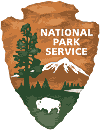Earth Science Week Classroom Activities
Rock Art in the National Parks

Activity Source:
Views of the National Parks, National Park Service. Adapted with permission.
Human beings have been linked to earth materials since prehistoric times. They used caves for shelter, shaped rocks into stone implements, and later refined metals to make tools. Beyond practical purposes, Earth materials also were used to make pigments for paint. Rock walls became canvases where ancient artists expressed themselves. In this exercise, we will explore the link between Earth materials and art.
Rock art — including petroglyphs (designs chipped into rock) and pictographs (designs painted on rock) — may be found in many national parks of the United States. These petroglyphs and pictographs consist of painted or chipped symbols resembling people, animals, plants, natural features, and abstract images. We can learn much about ancient peoples by studying the art left behind on rocks.
Archaeologists have discovered cave drawings as ancient as 30,000 years old in parts of Europe and Asia. Rock art is a priceless part of our geologic heritage that must be protected — so please do not touch the art and do not deface the paint or rock “canvas.”
Materials
- Egg carton
- Flat rocks (or brown wrapping paper)
- Natural painting tools, such as moss or grass
- Natural pigments:
Black = charcoal or soot
Green = crushed leaves or grass
Brown = soil
Shimmer = crushed mica or pyrite (“fool’s gold”)
Blue or purple = blueberries or purple grape skins
- Binders: egg whites or gum arabic
- Water
- Paper cups
- Computer with Internet access
Procedure
- Discuss: What connected ancient peoples and the Earth? What is the difference between petroglyphs and pictographs? How can we use this information to understand ancient ecosystems and cultures?
- Look at examples of rock art, and discuss what the symbols might represent. Information and images are available at the “Views of the National Parks” web site.
- Make your own paint using natural ingredients. First, fill egg carton hollows with various natural pigments.
- Slowly add a binder such as lightly beaten egg whites or gum arabic to one pigment (this holds pigment particles together and makes paint “stick”). Stir carefully until the pigment is fully mixed with the binder. Pour a little water slowly into the hollow while stirring the mixture. Keep adding water until the paint mixture turns into a liquid.
- After preparing the first paint, repeat the process by adding binder and water to the other pigments.
- Using your paint and natural tools, create a pictograph on a flat rock (or brown paper). Cave artists spread the paint with their fingers, with brushes made of reeds and hair, or with pads of moss. Create a symbol that represents something important in your life.
- Share your pictograph with the class, describing how the pictograph was created and its meaning. Discuss the importance of protecting pictographs as part of our geologic heritage.
